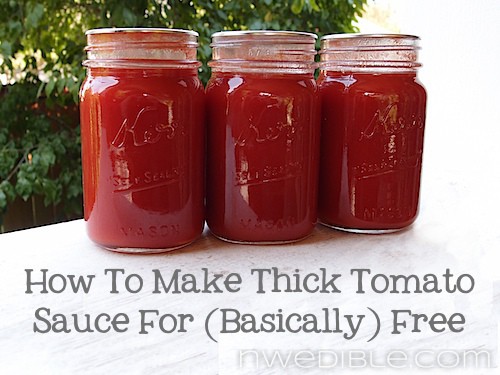
It has come to my attention that many people are unwittingly throwing away free tomato sauce when they preserve their summer tomatoes.
Here’s the thing: like all fruit, the skin of tomato is where much of the natural pectin resides. Pectin is the starch that gives jams their thickness and good tomato sauce its natural, noodle-coating thickness.
But tomato skins in a canned tomato product can be tough and stringy, and do that thing where they stick between your teeth and make you feel like you are getting a floss job from Satan’s dentist. This is why almost every canned tomato recipe calls for the initial step of coring, blanching and skinning tomatoes.
When you are working with 50 or 150 pounds of tomatoes at a time, those cores and skins really add up. If you are just chucking them to the chickens you are missing the opportunity to make really excellent – and essentially free – thick, smooth tomato sauce.
The Secret Ingredient is “Free”
Here’s what you do to turn all those “waste”skins into top-quality, pectin-rich, thick tomato sauce.
Sort tomatoes. Any that are showing signs of rot, mold or disease just chuck.
Wash all your perfect canning tomatoes. I wash my tomatoes in my previously-sanitized sink and add a small splash of bleach to the water. I do this because I will be saucing the skins and I want to cut down on any contaminants on them, but you can decide for yourself if you want to take this step, or perhaps substitute a good quantity of vinegar for the bleach. Because my tomatoes are locally hand-harvested they tend to be pretty clean, but I keep an eye out for any patches of dirt or pieces of tomato leaf and gently scrub these areas clean if necessary.
Rinse, dry and core tomatoes. Save those cores.
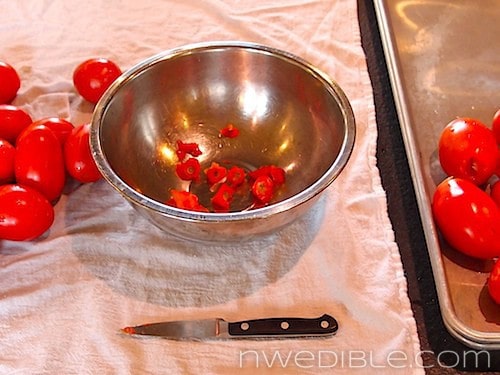
Because I’m right-handed, whenever possible I move from left-to-right when preparing produce for processing. I find this to be most efficient.
Blanch and slip the skins of the tomatoes. Save those skins.
Proceed to do whatever you were going to do anyway with all your peeled tomatoes. Save any extra juice or seeds from additional prep of the tomatoes.
Put all the clean cores, skins, juice and seeds you set aside in a big pot and start simmering. You can’t overcook this, but you can scorch it, so keep the heat on medium and give it a good stir every few minutes.
When everything in the pot is falling-apart tender, say after an hour or more of cooking, and you have a good break where you can attend to your sauce (the 85 minutes while whole peeled tomatoes process in a boiling water bath is an excellent time), puree the contents of the pot. The absolute easiest way to do this is with an immersion blender.
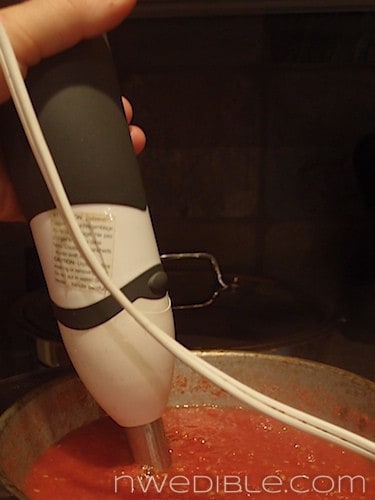
An immersion blender is the simplest, safest way to turn something hot and chunky into something hot and smooth.
Alternatively, you can let the mixture cool a bit and puree it in batches in a blender or food processor. Just a warning: hot liquids + blender = tomato sauce on the ceiling and scalded cook if you aren’t careful. Do a Google search on how to blend hot liquids before you go this route. (After which you will probably decide to take my advice and just go buy an immersion blender.)
When your sauce is smooth-ish, work it through a fine-mesh strainer or chinoise. Use a small ladle or spatula to push all the thick pulp through the strainer while leaving the now straw-like skins behind. Really go for it at this point – you don’t want to leave anything but dry skins and seeds in that strainer.
I strain my sauce directly into a second, clean stockpot. If all my large pots are in use, I strain into a large bowl, clean the original stockpot of any stuck-on tomato peels, and pour the finished stock back in.
Return your sauce to the heat and reduce until it is at your desired consistency. Season to taste with salt and, if desired, proceed to preserve by canning or freezing.
Remember, tomato sauce requires the addition of 1 tbsp of bottled lemon juice or ½ tsp citric acid per pint to be safely water bath canned. Here’s info on safe acidification practices for tomato products. Pints require 35 minutes of processing in a boiling water bath at sea level. Here’s additional information on safe ways to process tomato sauce.
Is It Worth It?
If you’ve never done this, you will probably be surprised at how much sauce you get from what you would have normally just thrown away.
These are the sauce yields from three separate tomato-processing events this summer:
Batch one: 150 pound of Roma tomatoes yielded 17 pints of thick, skin-based tomato sauce
Batch two: 40 pounds of Romas yielded 5 pints of thick, skin-based tomato sauce
Batch three: 50 pounds of Romas yielded 9 pints of thick, skin-based tomato sauce
So, depending on how much flesh clings to the skin of your tomatoes when you peel them and how much you reduce your stock, I’d estimate you will get 1 pint of finished sauce for every 6 to 9 pounds of canning tomatoes you peel and core.
This is a great way to eek as much possible goodness out of your harvest or hard-purchased tomatoes. From 90 total pounds of raw canning tomatoes, using this method to recapture sauce from the skins led to a total amount of composted waste of less than 3-and-a-quarter pounds. That’s a processing loss rate of about 3.5% which is, in my opinion, excellent.
If you are canning 50 pounds of tomatoes or more, you will definitely have enough skins to make this process worthwhile. If you work in smaller batches, you might consider saving all your cores and peels in the freezer until you have accumulated enough to make this food reclamation process make sense. The freezing of the peels will not noticeably impact the final texture of the sauce.
Free tomato sauce! And you don’t even have to dumpster dive to get it.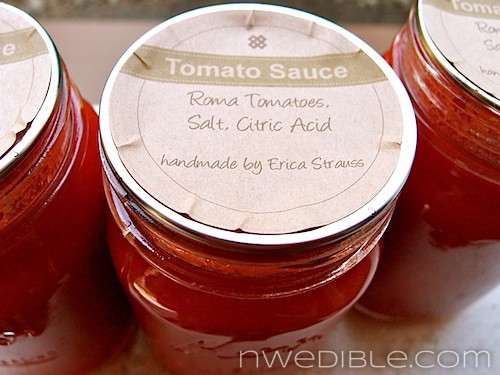
Not-Free Stuff That Helps A Lot When You Are Making Free Tomato Sauce:
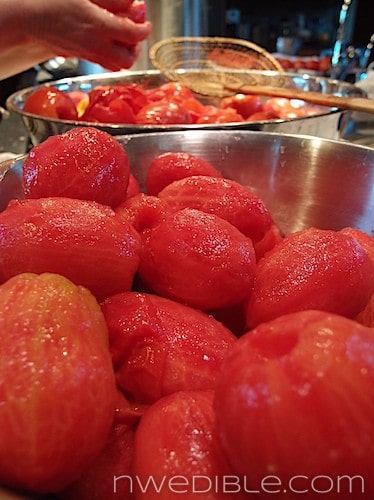


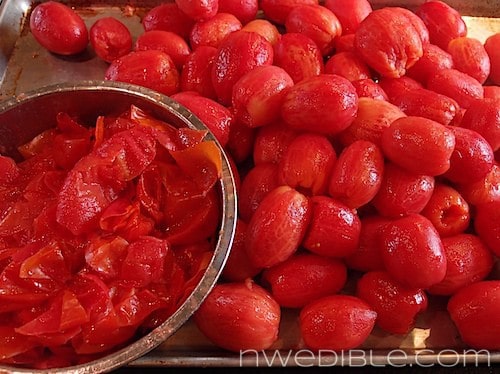
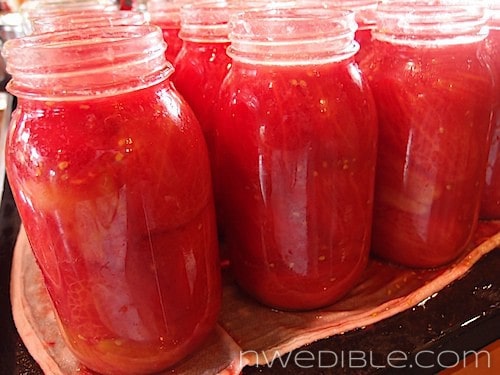
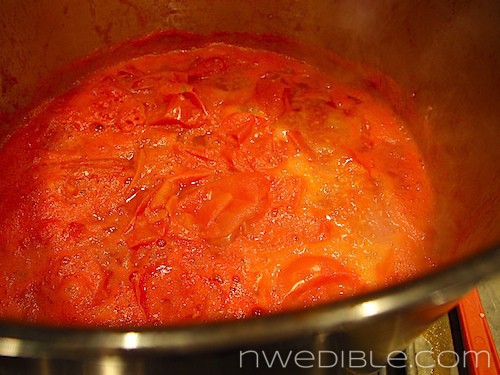
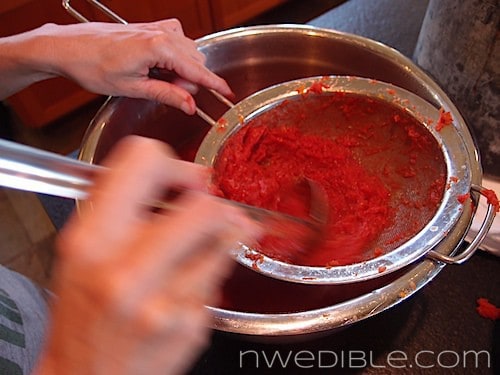
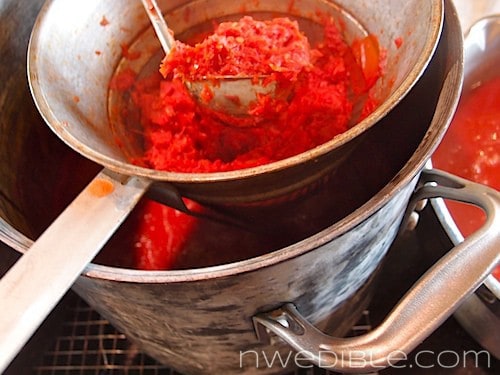

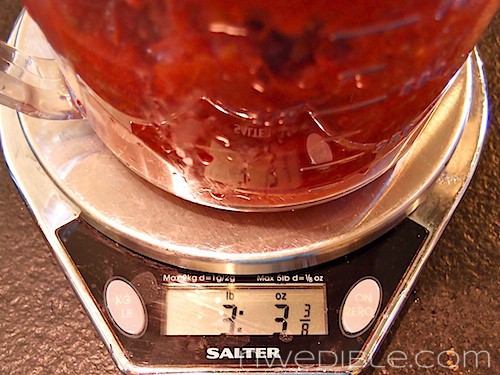



FDA guidelines for acidification are 1/2 teaspoon per quart, 1/4 teaspoon per pint. Using the 1/2 teaspoon per pint you recommend here won’t hurt anyone but it will make the tomato sauce more acidic than it needs to be for safety, and also make it a bit less tasty.
http://nchfp.uga.edu/how/can_03/tomato_intro.html#acidification
Erica,
I cannot believe how much Tomato Sauce I’ve chucked to the compost for years until today. I had saved the peels, cores, etc from 1 bushel tomato skins I today made 5 luscious pints of TOMATO SAUCE & it is delicious.
Thank you ever so much from a very happy canner. I so enjoy your recipes.
This is awesome. I process tomatoes in small batches for the freezer. I finally had a enough to try this. It was late when I finished roasting the tomatoes so I put all of the skins and cores in the Crock-Pot. In the morning, I blended everything up, strained it and ended up with a beautiful smooth tomato sauce, perfect for cooking. My chickens will get the seeds and little pieces of skin… Nothing wasted